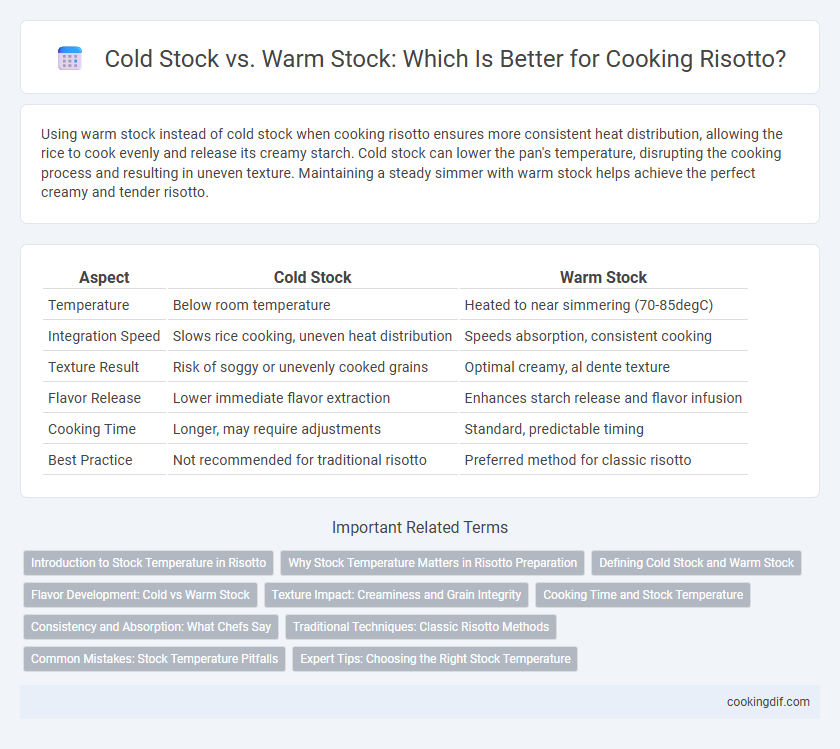Using warm stock instead of cold stock when cooking risotto ensures more consistent heat distribution, allowing the rice to cook evenly and release its creamy starch. Cold stock can lower the pan's temperature, disrupting the cooking process and resulting in uneven texture. Maintaining a steady simmer with warm stock helps achieve the perfect creamy and tender risotto.
Table of Comparison
| Aspect | Cold Stock | Warm Stock |
|---|---|---|
| Temperature | Below room temperature | Heated to near simmering (70-85degC) |
| Integration Speed | Slows rice cooking, uneven heat distribution | Speeds absorption, consistent cooking |
| Texture Result | Risk of soggy or unevenly cooked grains | Optimal creamy, al dente texture |
| Flavor Release | Lower immediate flavor extraction | Enhances starch release and flavor infusion |
| Cooking Time | Longer, may require adjustments | Standard, predictable timing |
| Best Practice | Not recommended for traditional risotto | Preferred method for classic risotto |
Introduction to Stock Temperature in Risotto
Using warm stock is essential for achieving the creamy texture in risotto as it maintains a consistent cooking temperature, allowing the rice to release starch evenly. Cold stock cools the pan, interrupting the cooking process and leading to unevenly cooked grains with less creaminess. Professional chefs emphasize warming stock to optimize the absorption rate and enhance the dish's overall flavor and texture.
Why Stock Temperature Matters in Risotto Preparation
Using warm stock is essential in risotto preparation because it maintains a consistent cooking temperature, allowing the rice to release starch evenly for a creamy texture. Cold stock can cause the cooking temperature to drop, interrupting the absorption process and resulting in unevenly cooked grains. Maintaining a steady simmer with warm stock ensures the risotto cooks uniformly, achieving the signature smooth and velvety finish.
Defining Cold Stock and Warm Stock
Cold stock refers to broth or cooking liquid that starts at a lower temperature, often refrigerated, and is gradually heated during the cooking process, which can affect the texture and flavor absorption of risotto. Warm stock, maintained at a simmering temperature, is traditionally preferred for risotto as it ensures even cooking and enhances the rice's creamy consistency by allowing it to release starch more effectively. Using warm stock speeds up the cooking process and helps achieve the desired creamy texture characteristic of an authentic risotto.
Flavor Development: Cold vs Warm Stock
Using warm stock in risotto enhances flavor development by promoting even heat distribution, allowing the rice to release starch gradually and absorb the broth's savory essence. Cold stock can slow the cooking process, resulting in uneven texture and less integrated flavors. Maintaining the stock at a consistent warm temperature optimizes the creamy consistency and rich taste characteristic of traditional risotto.
Texture Impact: Creaminess and Grain Integrity
Using warm stock in risotto enhances creaminess by promoting gradual starch release, resulting in a smooth and velvety texture. Cold stock can cause uneven cooking, leading to a grainy texture and uneven starch gelatinization. Maintaining consistent temperature with warm stock preserves the integrity of the rice grains, producing a perfectly al dente bite and optimal creaminess.
Cooking Time and Stock Temperature
Using warm stock in risotto cooking significantly reduces the overall cooking time by maintaining a consistent temperature, allowing the rice to absorb liquid more efficiently. Cold stock cools the pan each time it's added, prolonging the cooking process and potentially leading to unevenly cooked grains. Optimal risotto texture relies on gradually incorporating warm stock, ensuring creamy consistency and perfect al dente results.
Consistency and Absorption: What Chefs Say
Chefs emphasize that warm stock is essential for achieving the ideal consistency and optimal absorption in risotto, as it maintains a consistent temperature, allowing the rice to release starch evenly. Cold stock can lower the cooking temperature, resulting in uneven texture and longer cooking times that affect creaminess. Using warm stock ensures the rice grains swell uniformly, producing the signature smooth and velvety texture prized in authentic risotto dishes.
Traditional Techniques: Classic Risotto Methods
Traditional risotto methods emphasize using warm stock, as it ensures consistent temperature and optimal starch release from the rice, resulting in a creamy texture. Cold stock can cause temperature fluctuations, interrupting the cooking process and yielding unevenly cooked grains. Maintaining warm stock aligns with classic Italian techniques, preserving the signature smoothness and rich flavor of an authentic risotto.
Common Mistakes: Stock Temperature Pitfalls
Using cold stock instead of warm stock when cooking risotto slows down the absorption process, leading to uneven texture and extended cooking time. Warm stock maintains a consistent temperature, ensuring the rice cooks evenly and releases starch properly for a creamy finish. A common mistake is neglecting to keep the stock hot, which disrupts the delicate balance required for perfect risotto consistency.
Expert Tips: Choosing the Right Stock Temperature
Using warm stock in risotto cooking ensures even absorption and maintains a consistent cooking temperature, which is crucial for achieving the creamy texture characteristic of authentic risotto. Cold stock can cause the cooking process to stall, resulting in unevenly cooked rice and a less creamy final dish. Expert chefs recommend keeping stock at a gentle simmer to enhance starch release from the arborio rice and optimize the dish's flavor and texture.
Cold stock vs Warm stock for cooking Infographic

 cookingdif.com
cookingdif.com